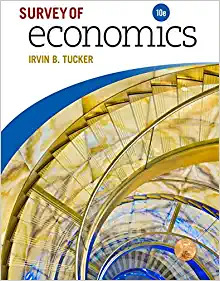Question
Show your workings 1. In the second half of 2020, economists predicted that in the absence of a new fiscal stimulus package, concerns about the
Show your workings
1. In the second half of 2020, economists predicted that in the absence of a new fiscal stimulus package, concerns about the possibility of infection and loss of income due to the COVID-19 pandemic would reduce household spending on good and services produced in the US by about $235 billion in 2021. At the end of 2020, the US government implemented a $120 billion cash transfer program by delivering $600 tax-free stimulus checks to 200 million Americans. For the purposes of this exercise, please ignore the other components of the actual stimulus package that was signed into law at the end of 2020. Assume that the stimulus package has no impact on other government expenditure, investment, or exports of the US economy. Also, assume that households start to spend their stimulus transfers in 2021 and for every dollar of increase in their disposable income (earnings net of taxes), they spend $0.60 on goods and services and save the rest. Finally, assume that for every dollar of spending, the US imports $0.20 worth of goods and services and the rest, $0.80, is spent on U.S. products.
(a) What will be the direct impact of the stimulus transfer on the total private spending in 2021? Please show/explain the logic of your calculations, in addition to the final answer. [4]
Answer:
(b) What will be the direct impact of the stimulus transfer on U.S. imports? Please show/explain the logic of your calculations, in addition to the final answer.[4]
Answer:
(c) What will be the direct impact of the stimulus transfer on the total private spending on U.S. products? Please show/explain the logic of your calculations, in addition to the final answer.[4]
Answer:
(d) The increased amount of spending on U.S. products that you calculated in part (c) will be earned by American households, which will induce a second-round of increase in consumption expenditure. If the average tax rate is 20 percent, what will be the increase in household disposable income (i.e., after-tax income) in that second round? Please show/explain the logic of your calculations, in addition to the final answer. [5]
(f) Compare the total increase in consumer spending on U.S. goods and services in all rounds 1-12 with the stimulus transfer itself. Calculate the increase in spending on U.S. goods and services as a percentage of the initial stimulus transfer. Please show/explain the logic of your calculations, in addition to the final answer. [5]
Answer:
(g) Assume that the economists' estimate of $235 billion household expenditure shortfall in the absence of the stimulus transfers (as discussed in the setting for this exercise) is correct. Will the stimulus transfer be adequate to compensate for that shortfall in the demand for U.S. goods and services? Please show/explain the logic of your calculations, in addition to the final answer. [4]
Answer:
(h) How much of the rest of the world's savings should be transferred to the U.S. to meet the additional import demand in the U.S. generated by the stimulus package? Please show/explain the logic of your calculations, in addition to the final answer. [5]
Answer:
(i) How will household savings and total domestic savings change as a result of the stimulus package? Please show/explain the logic of your calculations, in addition to the final answer. [8]
Answer:
(j) If the US government wanted to set the size of each stimulus check such that it would end up raising the total household spending on U.S. goods and services by $235 billion, how much should it have paid to each of the 200 million Americans who received the check? Please show/explain the logic of your calculations, in addition to the final answer. [5]
Answer:
(k) The Biden administration that took office in January 2021 topped the $600 check paid at the end of 2020 with a $1400 check, raising the total stimulus pay to $2000 per recipient, or $400 billion total stimulus pay for all households. How does this amount compare with the stimulus needed to compensate for the $235 billion reduction in consumer spending due to the pandemic? How much did the total stimulus exceed or fall short of the amount needed? Please show/explain the logic of your calculations, in addition to the final answer. [4]
Answer:
Step by Step Solution
There are 3 Steps involved in it
Step: 1

Get Instant Access to Expert-Tailored Solutions
See step-by-step solutions with expert insights and AI powered tools for academic success
Step: 2

Step: 3

Ace Your Homework with AI
Get the answers you need in no time with our AI-driven, step-by-step assistance
Get Started


